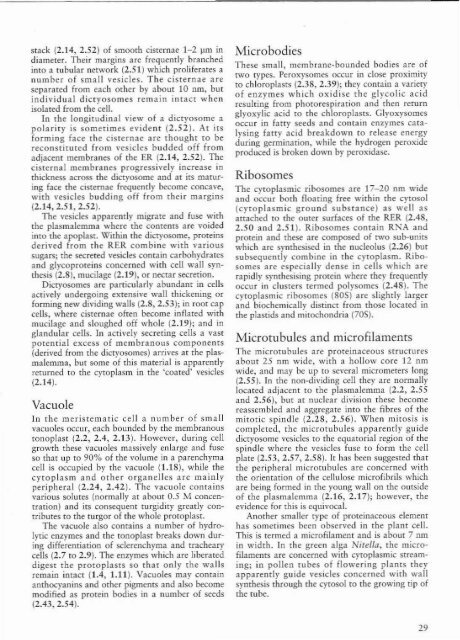You also want an ePaper? Increase the reach of your titles
YUMPU automatically turns print PDFs into web optimized ePapers that Google loves.
stack (2.14, 2.52) of smooth cisternae 1-2 I-lm in<br />
diameter. Their margins arc frequemly branched<br />
imo a tubular network (2.51) which proliferates a<br />
number of small vesicles. The cisternae are<br />
separated from each other by about 10 nm, but<br />
individual dictyosomes remain intact when<br />
isolated from the cell.<br />
In the longitudinal view of a dictyosome a<br />
polarity is sometimes evident (2.52). At its<br />
forming face the cisternae are thought to be<br />
reconstituted from vesicles budded off from<br />
adjacent membranes of the ER (2.14,2.52). The<br />
cisternal membranes progressively increase in<br />
thickness across the dictyosome and at irs maturing<br />
face the cisternae frequently become concave,<br />
witb vesicles budding off from their margins<br />
(2.14,2.51,2.52).<br />
The vesicles apparently migrate and fuse with<br />
the plasmalemma where the contents are voided<br />
into the apoplasr. Within the dict)'osome, proteins<br />
derived from the RER combine with various<br />
sugars; the secreted vesicles contain carbohydrates<br />
and glycoproteins concerned with cell wall synthesis<br />
(2.8), mucilage (2.19), or nectar secretion.<br />
Dicryosomes are particularly abundant in cells<br />
actively undergoing extensive wall thickening or<br />
forming new dividing walls (2.8, 2.53); in root cap<br />
cells, where cisternae often become inflated with<br />
mucilage and sloughed off whole (2.19); and in<br />
glandular cells. In actively secreting cells a vast<br />
pOtential excess of membranous components<br />
(derived from the dicryosomes) arrives at the plasmalemma,<br />
but some of this material is apparently<br />
returned to the cytoplasm in the 'coated' vesicles<br />
(2.14).<br />
Vacuole<br />
1n the meristematic cell a number of small<br />
vacuoles occur, each bounded by the membranous<br />
tonoplast (2.2, 2.4, 2.13). However, during cell<br />
growth these vacuoles massively enlarge and fuse<br />
so that up to 90% of the volume in a parenchyma<br />
cell is occupied by the vacuole (1.18), "while the<br />
cytoplasm and other organelles are mainly<br />
peripheral (2.24, 2.42). The vacuole contains<br />
various solutes (normally at aboUT O.S M concentration)<br />
and its consequent turgidity greatly contributes<br />
to the [Urgor of the whole protoplast.<br />
The vacuole also contains a number of hydrolytic<br />
enzymes and the tonoplast breaks dmvn during<br />
differentiation of sclercnchyma and tracheary<br />
cells (2.7 to 2.9). The enzymes which are liberated<br />
digest the proroplasts so that only the walls<br />
remain intact (lA, 1.11). Vacuoles may contain<br />
anthocyanins and other pigments and also become<br />
modified as protein bodies in a number of seeds<br />
(2.43,2.54).<br />
Microbodies<br />
These small, membrane-bounded bodies are of<br />
two types. Pcroxysomes occur in close proximity<br />
to chloroplasts (2.38, 2.39); they contain a variety<br />
of enzymes which oxidise the glycolic acid<br />
resulting from photorespiration and then return<br />
glyoxylic acid to the chloroplasts. Glyoxysomes<br />
occur in fatty seeds and contain enzymes catalysing<br />
fatty acid breakdown to release energy<br />
during germination, while the hydrogen peroxide<br />
produced is broken down by peroxidase.<br />
Ribosomes<br />
The cytoplasmic ribosomes are 17-20 nm wide<br />
and occur both floating free within the cytosol<br />
(cytoplasmic ground substance) as well as<br />
attached to the outer surfaces of the RER (2.48,<br />
2.50 and 2.51). Ribosomes contain RNA and<br />
protein and these are composed of two sub-units<br />
which are synthesised in the nucleolus (2.26) bur<br />
subsequentiy combine in the cytoplasm. Ribosomes<br />
arc especially dense in cells which are<br />
rapidly synthesising protein where they frequently<br />
occur in clusters termed polysomes (2.48). The<br />
cytoplasmic ribosomes (80S) are slightly larger<br />
and biochemically distinct from those located in<br />
the plastids and mitochondria (70S).<br />
Microtubules and microfilaments<br />
The microtubules are proteinaceous structures<br />
about 25 nm wide, with a hollow core 12 nm<br />
wide, and may be up to several micrometers long<br />
(2.55). In the non-dividing cell they are normally<br />
located adjacent to the plasmalemma (2.2, 2.55<br />
and 2.56), bur at nuclear division these become<br />
reassembled and aggregate into the fibres of the<br />
mitotic spindle (2.28, 2.56), When mitosis is<br />
completed, the microtubules apparently guide<br />
dictyosome vesicles to the equatorial region of the<br />
spindle where the vesicles fuse to form the cell<br />
plate (2.53. 2.57, 2.58). It has been suggested that<br />
the peripheral microtubules arc concerned with<br />
the orientation of the cellulose microfibrils which<br />
are being formed in the young wall on rhe outside<br />
of the plasmalemma (2.16, 2.17); however, the<br />
evidence for [his is equivocal.<br />
Another smaller type of proteinaceous element<br />
has sometimes been observed in [he plant cell.<br />
This is termed a microfilament and is abom 7 run<br />
in width. In the green alga Nite/la, the micro·<br />
filaments a.re concerned with cytoplasmic streaming;<br />
in pollen tubes of flowering plants they<br />
apparentl)' guide vesicles concerned with wall<br />
synthesis through the cytosol to the growing tip of<br />
the tube.<br />
29





